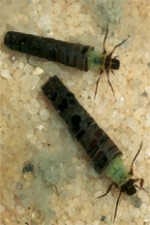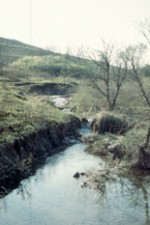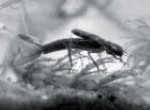“Distribution, Abundance and Dynamics of Stream Macroinvertebrates: Metapopulation Dynamics and Metacommunity Structure”
A new study tests the applicability of a major hypothesis, using data sets from several research sites, including five LTERs.
A group of LTER investigators, as well as some ‘outsiders’ have been funded by the LTER-intersite initiative to look at common stream invertebrate datasets. “In particular,” says David Gibson of Konza Prairie LTER and coinvestigator on the project, “we are investigating the applicability of the Core-Satellite Species Hypothesis and metacommunity models for interpreting these large datasets through space and time.”
The LTER folks involved include David Gibson (KNZ), Matt Whiles (KNZ, CWT), Scott Collins (SEV, KNZ), Bob Hall (HBR), and Alex Huryn (ARC), as well as Tom Heatherly from Southern Illinois University, John Jackson of the Stroud Water Research Center in Philadelphia, and Margaret Palmer of the University of Maryland. The field sites for this study are located at Konza Prairie, Coweeta, Hubbard Brook, and Arctic LTERs, as well as at sites in Alabama, Maine, Maryland, New York, Pennsylvania, and New Zealand.
The Core-Satellite Species hypothesis is a metapopulation model of community structure and composition that allows for the incorporation of regional scaling processes into the understanding of community structure and ecosystem function. The CSS relates to the proportion of patches (in this case, sites that were sampled) occupied by a species and predicts that the core species are those widely distributed and abundant in space, while satellite species are rare and patchy in their distribution. Thus, the hypothesis predicts a bimodal distribution of site occupancy frequencies. This model has been used successfully in the past by Scott Collins (SEV, KNZ) to understand plant, bird, and small mammal communities at Konza Prairie. “Regionalization is a key goal of the LTER Network strategic plan,” says Scott Collins, a Konza Prairie researcher, now located at Sevilleta LTER. “Our working group is proposing to conduct one of the first analyses of metacommunity structure for stream invertebrate communities.” In addition, the stream datasets allow the testing of some of the recently proposed metacommunity models (e.g., nestedness sensu Atmar and Patterson, 1993; and coherence sensu Leibold & Mikkelson, 2002).
One of the goals of the project is to determine the degree to which local stream insect communities are linked regionally into metacommunities. A metacommunity, or a set of local communities in different locations, is coupled by dispersal of one or more of their constituent members (Gilpin & Hanski 1991).
The data sets cover a time frame from 1989 through 2002. Most data sets are from a single year, but some cover longer periods, eg., a spatial data set from New York spans 2000-2002. Within a year many of the datasets represent monthly or bimonthly samples.
This project brings a diverse group of investigators with large datasets together for the first time and represents an important synthesis activity among investigators at different sites. The partnership between LTER and non-LTER studies also expands the impact of the four LTER sites and provides a framework for stronger interpretations studies— inside LTER and beyond.
The purpose of the study is to understand the structure of stream invertebrate communities across temporal (year-to-year, and within years) and spatial (within and between regions) scales. “But a preliminary analysis of data from Konza Prairie indicated a potential difficulty in using stream invertebrate data to fit an important metapopulation model of community structure,” i.e., the Core- Satellite Species hypothesis (CSS).
Gibson says, “One significant problem that we identified was that stream invertebrates are often identified to different levels of taxonomic resolution, depending on the scope of the study and the principal investigators involved.” Sometimes taxa are identified to species, sometimes just to genus, and for some groups, only to family. “Looking at four stream reaches on Konza from 1988-2000, it appeared that the data provided a good fit to the bimodal prediction of the CSS,” Gibson says. “However, when 11 groups of uncertain taxonomic resolution were removed from the analysis, the fit was lost. We realized that to address the CSS across several dataset we would need to work closely with the original investigators of each group so that issues of taxonomic resolution could be discussed.”
The datasets were generally in good shape and were provided directly by the investigators that are part of the group, according to co-investigator Matt Whiles. “However, the group has spent considerable time putting them into a common format for this particular analysis, and a big part of the project is standardizing the taxonomy, and deciding which level of taxonomic resolution to retain across datasets,” Whiles says. “For example, we quickly removed all non-insect taxa from our datasets when we realized that these were almost always incompletely resolved.”
Gibson says the excellent level of cooperation among investigators has made the project a pleasure. “The funding has been critical for working with the data and getting together as a group,” Gibson says. “And the LTER infrastructure is helpful in providing a context to work under for most of the datasets.”
“The results of this project will provide important insight into stream invertebrate communities across spatial and temporal scales,” Gibson says. “The results will also allow us to assess any commonality in patterns of temporal dynamics across large regional scales.” The project also drives home the need for comparability among data from disparate locations.
References
Atmar, W., and B.D. Patterson. 1993. The measure of order and disorder in the distribution of species in fragmented habitat. Oecologia 96:373-382.
Gilpin, M.E., and I. Hanski. Eds. 991. Metapopulation dynamics: empirical and theoretical investigations.
Leibold, M.A., and G.M. Mikkelson. 2002. Coherence, species turnover, and boundary clumping: elements of metacommunity structure. Oikos 97: 237- 250

 Enlarge this image
Enlarge this image



